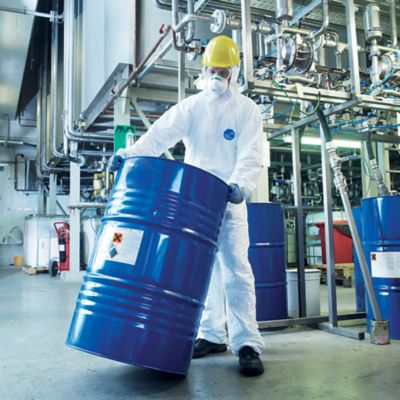Before responders enter a spill area, they need to be properly protected from hazards and trained on various aspects of the Personal Protective Equipm

Ideally, the spilled liquid will be identified prior to response. This helps responders determine the types of PPE needed for safe response and helps avoid the use of more costly response equipment if not needed. Using the SDS for the chemical, or other available guides, responders can quickly choose equipment that will protect them from the spill.
Assessing Suitable PPE
In order to choose the right PPE, carefully consider the different potential hazards in the workplace. This determines the PPE that is suitable to protect against the hazard and for the job to be done.
Ask your supplier for advice on the different types of PPE available and how suitable they are for different tasks. It may be necessary in a few particularly difficult cases to obtain advice from specialist sources and from the PPE manufacturer.
Here are a few questions to ask when assessing whether PPE is suitable:
- Is it appropriate for the risks involved and the conditions at the place where exposure to the risk may occur? (For example, eye protection designed for providing protection against agricultural pesticides will not offer adequate face protection for someone using an angle grinder to cut steel or stone.)
- Does it prevent or adequately control the risks involved without increasing the overall level of risk?
- Can it be adjusted to fit the wearer correctly?
- Has the state of health of those who will be wearing it been taken into account?
- What are the needs of the job and the demands it places on the wearer (e.g., the length of time the PPE needs to be worn, the physical effort required to do the job and the requirements for visibility and communication)?
- If more than one item of PPE is being worn, are they compatible? For example, does a particular type of respirator make it difficult to get eye protection to fit properly?
Types of PPE
Many styles and types of PPE are available to protect different areas of the body from a myriad of hazards. Responders should be familiar with the PPE available to them, and chemical resistance guides should be readily available to help responders and safety officers quickly choose the proper protection in the event of a spill. Some common forms of PPE are:
Suits – protect workers’ bodies from chemical splashes as well as harmful dusts, vapours and mists. Various types are available depending on the degree of hazard present.
Gloves – protect hands from chemicals, punctures, heat and/or cold.
Goggles – protect eyes and face from chemical splashes, flying particles, dust, etc.
Boots Covers – protect workers’ feet from exposure to chemicals and/or abrasive surfaces or debris.
Playing it safe
Just because responders are wearing the proper PPE doesn’t mean that they instantly become invulnerable. In fact, because the PPE and equipment they are wearing is not part of their everyday routine, responders must be twice as cautious. PPE is usually the last resort after other methods of protection have been considered, it is therefore important that users wear it all the time they are exposed to the risk. Never allow exemptions for those jobs which take “just a few minutes”.
The best way for responders to be aware of the limitations of their PPE is through training and drills. An actual spill is not the time for someone to first experience restricted mobility, limited peripheral vision and lack of dexterity. Everyone using PPE should be aware of why it is needed, when it is to be used, repaired or replaced and its limitations. Regular checks should also be conducted to check that PPE is being used and investigate fully any reasons why it is not. Safety signs can be useful reminders to wear PPE.
Planning for safety
Assessing the risk and wearing the proper protection when responding to spills takes time. But, just as no one leaves for vacation without first packing a suitcase, the time spent minimising risks will be well rewarded when responders are able to safely clean up the spill as effectively and efficiently as possible.
Find out more:
New Pig provides a comprehensive range of Personal Protective Equipment from our online shop. Or why not give us a call on 0800 919 900.






COMMENTS